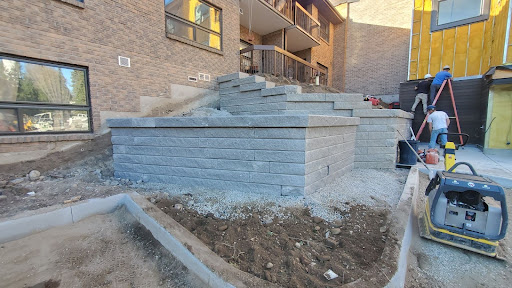In the landscape design world, there is a wide variety of hardscapes that can bring visual interest and personality to your outdoor space. There are only a few among these garden architecture features that are both functional and ornamental. Retaining walls bring both beauty and function to landscaped areas by preventing soil erosion and increasing usable flat space on sloped terrain.
While retaining walls are usually constructed to serve a functional purpose, they can also be visually stunning. While all outdoor spaces can benefit from incorporating a retaining wall, they benefit sloped properties the most.
What is a Retaining Wall?
A retaining wall is a relatively rigid wall that is used to support soil laterally and ensure that the soil is effectively retained at varying levels on the two sides. Retaining walls are structures that are designed to contain soil to a slope that it would not organically keep to (typically a very steep, almost vertical, or vertical slope). These walls are commonly used to restrain soils between two differing elevations and are most often created in areas that possess undesirable slopes.
What are the Functional Benefits of Retaining Walls?
While retaining walls serve many beneficial functions, the most notable function is to prevent the erosion of soil. They achieve this by holding the soil in place firmly against the anchored wall, thus forcing the soil to indefinitely maintain its position.
Other benefits of retaining walls in landscaped outdoor spaces include the prevention of rainwater rushing down a sloped area, increasing usable space, and creating levels and visual interest in your outdoor space.
Retaining Walls Can Be Functional & Visually Appealing
Functionality doesn’t always have to be plain or boring! Apart from being valuable structures, retaining walls can also be ornamental and improve the aesthetics of your yard, patio, or garden terrace. While retaining walls are primarily practical, they can also be customized in many ways to create a unique look.
One option for customizing a retaining wall includes choosing from a variety of materials to best fit your existing landscape and allow the retaining wall to effectively blend into the space. Planter beds can also be added to the top of retaining walls to increase planting space and add a pop of colour.
As well as the retaining wall itself, the flat area that is created can also be used to enhance the visual interest of your outdoor space. This might mean adding a new patio space, or another focal point that will designate a specific area of your yard to relax and enjoy the outdoors.
There is a wide variety of materials available for creating retaining walls and retaining structures; some of the most popular materials used to create a retaining wall are segmental retaining wall blocks and precast modular blocks. Segmental retaining wall blocks (SRW) are machine-produced dry-cast concrete products with uniform length, width, and height. When using SRWs for a retaining wall, the same block size is generally used for the entire wall. Precast modular blocks (PMB) are produced form wet-cast concrete and have a base length and width that are greater than the height of the block. PMB-constructed retaining walls typically include blocks of varying sizes and weights with the larger blocks being installed on the bottom.
What Kind of Outdoor Spaces Benefit from a Retaining Wall?
Due to the primary purpose of retaining walls, they are most useful when built on properties that have significant sloping and as a result, that space would be otherwise unusable. With that being said, virtually any property could benefit from a feature or structure such as a retaining wall, as they don’t have to be purely functional. Some homeowners decide to integrate a retaining wall into their outdoor space to create levels and visual interest. They can also help to encourage the growth of a tiered hedge or to increase usable space, even on flat ground.
Creating a Retaining Wall
The creation of a retaining wall is best left to the professionals. The process typically involves a great deal of planning and strategy, accurate mapping and measurements of the existing space, digging a trench and leveling the ground, and then building the retaining wall itself. This process can be complicated and labour intensive and requires the knowledge and experience of expert landscape professionals to safely and properly complete.
The Bottom Line
Retaining walls are popular features of landscaped yards and gardens that can create a visually exciting and functional element within your outdoor space. While these walls create structural support, prevent soil erosion, and increase the usability of the space, they also offer opportunities to make your space unique, creative, and aesthetically pleasing.
If you believe your property is in need of a retaining wall, or have an existing retaining wall that requires replacement contact us at Mountview Services today!

